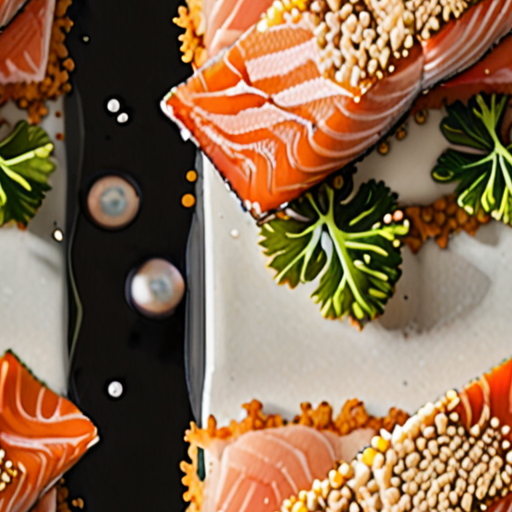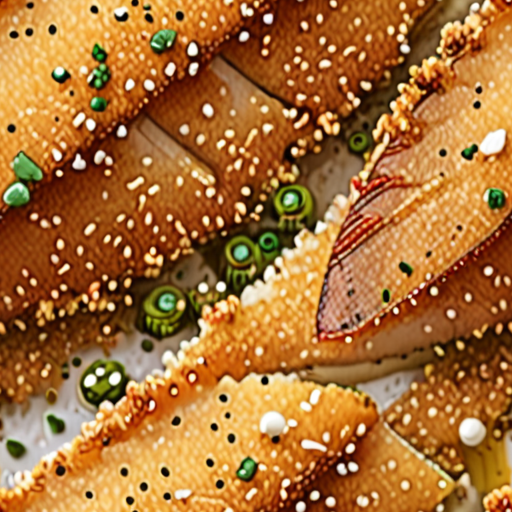When it comes to preparing a delicious meal, few options are as satisfying as a perfectly cooked piece of pan-fried fish. Whether you’re a seasoned chef or a culinary novice, mastering the art of pan-fried fish recipes can elevate your cooking skills and impress even the most discerning palates. From the type of fish to choose, to the ideal fat to use for frying, and the perfect coating to achieve a crispy exterior, there are numerous factors to consider when creating a mouth-watering pan-fried fish dish.

The Best Fish to Pan Fry
Firm and flaky fish like cod, tilapia, snapper, or salmon work well for pan-frying.
- Cod has a mild flavor and firm texture making it ideal for pan-frying.
- Tilapia is another popular choice due to its delicate flavor and soft texture.
- Snapper has a slightly sweet flavor and firm texture that holds up well to high heat.
- Salmon is a great option for those looking for a heartier fish with a rich flavor.
When choosing a fish for pan-frying, look for fillets of even thickness to ensure consistent cooking.
Season the fish with salt, pepper, and any other desired herbs or spices before cooking.
Heat a skillet over medium-high heat and add a small amount of oil to prevent sticking.
Add the fish to the skillet and cook for 3-4 minutes per side, or until cooked through.
Serve hot and enjoy!
Pan-Frying Tips
- Make sure the skillet is hot before adding the fish.
- Don’t overcrowd the skillet – cook the fish in batches if necessary.
- Don’t press down on the fish with your spatula – this can cause it to break apart.
- Let the fish rest for a minute or two before serving.
Recommended Cooking Tools
- Skillet: A stainless steel or cast iron skillet is ideal for pan-frying fish.
- Oven mitts: Protect your hands from burns when removing the skillet from the oven.
- Spatula: A rubber spatula is perfect for gently flipping the fish.
Is it Better to Pan Fry Fish in Butter or Oil?
When it comes to pan-frying fish, choosing the right cooking medium can make all the difference in achieving a delicious and crispy exterior while preserving the tender interior.
- Butter: While butter can add a rich and creamy flavor to your fish, it’s not the best choice for pan-frying due to its low smoke point. Butter can easily burn and develop an unpleasant flavor, which may overpower the delicate taste of the fish.
- Olive Oil: On the other hand, olive oil is a popular choice for pan-frying fish due to its mild flavor and relatively high smoke point. However, not all olive oils are created equal, and some may have a strong flavor that could dominate the taste of the fish.
The Best Cooking Medium for Pan-Frying Fish
For optimal results, consider using a neutral-tasting oil with a high smoke point, such as avocado oil or grapeseed oil. These oils will allow you to achieve a crispy exterior and a tender interior without overpowering the flavor of the fish.
Tips for Achieving Perfectly Cooked Fish
- Make sure the fish is dry and pat it down with paper towels before cooking to prevent excess moisture from affecting the texture.
- Heat the oil in a skillet over medium-high heat until it reaches the ideal temperature for searing the fish.
- Cook the fish for 2-3 minutes per side, depending on the thickness and type of fish.
- Don’t overcrowd the skillet, cook the fish in batches if necessary, to ensure even cooking and prevent steaming instead of searing.
By following these tips and choosing the right cooking medium, you’ll be well on your way to creating perfectly cooked and delicious pan-seared fish every time.

Soaking Fish Before Frying
To achieve a crispy exterior and a tender interior when frying fish, it’s essential to prepare the fish properly before cooking.
- Buttermilk Soak: One popular method involves soaking the fish in buttermilk for several hours or overnight. This helps to tenderize the fish and creates a better surface for the coating to adhere to.
- Milk Alternative: Regular milk can be used as a substitute if buttermilk is not available. However, keep in mind that the results may vary slightly.
- Other Options: Some people swear by soaking fish in acidic ingredients like lemon juice or vinegar to enhance flavor and texture.
When choosing a soaking liquid, consider the type of fish you’re working with and the flavor profile you’re aiming for. Delicate fish like sole or flounder might benefit from a lighter touch, while heartier fish like salmon or tuna can handle a bolder approach.
Tips for Effective Soaking
- Temperature Control: Keep the soaking liquid refrigerated at a temperature below 40°F (4°C) to prevent bacterial growth and foodborne illness.
- Acidity Level: Adjust the acidity level of the soaking liquid according to the type of fish and desired flavor outcome.
- Soaking Time: Allow the fish to soak for the recommended time, but feel free to adjust based on personal preference and the thickness of the fish.
Common Mistakes to Avoid
Avoid over-soaking the fish, as this can lead to a mushy texture and unpleasant flavor. Also, be mindful of cross-contamination and ensure that all utensils and equipment are sanitized before handling raw fish.
By following these guidelines and experimenting with different soaking liquids and techniques, you’ll be well on your way to achieving perfectly cooked fried fish every time.

Why You Need to Flour Fish Before Pan Frying
The process of flouring fish before pan-frying may seem unnecessary, but it serves several purposes that can elevate the overall quality of your dish.
- Prevents Sticking
- Insulates the Surface
- Enhances Texture
Flouring the fish creates a barrier between the delicate flesh and the hot pan, preventing it from sticking and making it easier to remove once cooked.
The flour coating acts as an insulator, helping to retain moisture within the fish and prevent it from drying out during the cooking process.
A light dusting of flour can also contribute to a crisper exterior and a tender interior, adding texture and visual appeal to your finished dish.
When selecting a type of flour for coating, consider using a light, airy option like all-purpose flour or cornstarch, which won’t overpower the natural flavors of the fish.
To ensure the best results, pat the fish dry with paper towels before applying the flour coating, and gently shake off any excess to prevent clumping.
By incorporating this simple step into your pan-frying routine, you’ll be well on your way to achieving perfectly cooked, restaurant-quality fish every time.
Do You Dip Fish in Egg or Flour First?
To achieve the perfect crispy exterior and tender interior when frying fish, it’s essential to understand the correct order of coating.
- Dip fish pieces into the flour first, making sure to coat all sides evenly. This helps create a solid foundation for the breading.
- Next, dip the floured fish into the beaten eggs, ensuring complete coverage. The eggs act as a binding agent, helping the breadcrumbs adhere to the fish.
- Finally, sprinkle the panko breadcrumbs onto the egg-coated fish, gently pressing them onto the surface to secure the coating.
By following this sequence, you’ll end up with a beautifully breaded and fried piece of fish that’s sure to impress.
The Science Behind the Coating Order
The reason we start with flour is that it provides a dry surface for the eggs to adhere to. If we were to dip the fish in eggs first, the moisture would prevent the flour from sticking properly.
The eggs then bind to the flour, creating a strong bond between the two ingredients. Finally, the panko breadcrumbs cling to the egg coating, resulting in a crunchy exterior and a juicy interior.
Tips for Achieving the Perfect Breading
For an extra crispy coating, try chilling the breaded fish in the refrigerator for 30 minutes before frying.
Also, don’t overcrowd the pan when frying – cook the fish in batches if necessary, to ensure even cooking and prevent steaming instead of browning.
With these simple steps and a bit of practice, you’ll be well on your way to becoming a master fryer and impressing your friends and family with your delicious homemade fish dishes.

Choosing the Best Flour to Coat Fish
When it comes to coating fish, selecting the right type of flour can make all the difference in achieving a crispy exterior and a tender interior.
- Cornmeal: A popular choice for coating fish, cornmeal adds a nice crunch and helps to prevent the fish from sticking to the pan.
- Rice Flour: Light and delicate, rice flour is an excellent option for those looking for a gluten-free alternative.
- Oat Flour: Oat flour adds a slightly nutty flavor and a satisfying texture to coated fish.
- Gluten-Free Mix: Made from a blend of potato starch, rice flour, or garbanzo flour, gluten-free mixes offer a convenient solution for those with dietary restrictions.
- Almond Meal: Almond meal provides a rich, nutty flavor and a delicate texture, making it ideal for those looking for a unique twist on traditional coatings.
When choosing a flour to coat fish, consider factors such as texture, flavor, and dietary restrictions. Experiment with different options to find the perfect combination that suits your taste preferences.
Tips for Coating Fish
- Make sure to pat the fish dry before coating to remove excess moisture.
- Use a light dusting of flour to prevent overpowering the delicate flavor of the fish.
- Experiment with different seasoning blends to add extra flavor to your coated fish.
Conclusion
The best flour to coat fish ultimately depends on personal preference and dietary needs. By exploring various options and experimenting with different combinations, you can find the perfect coating to elevate your fish dishes to the next level.

0 Comments